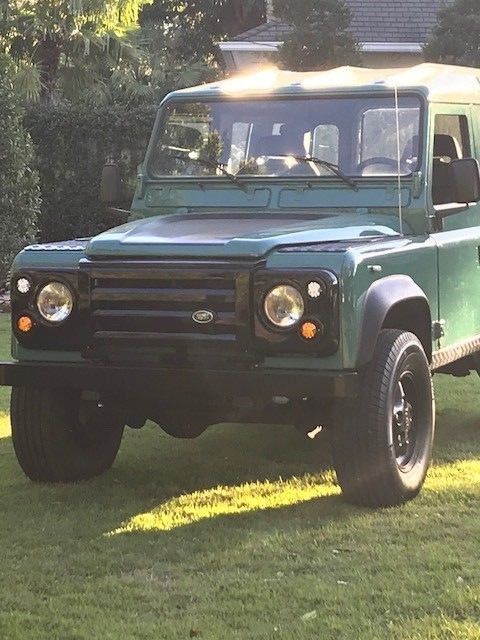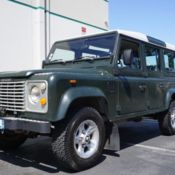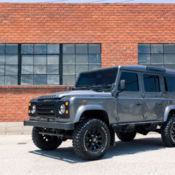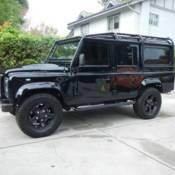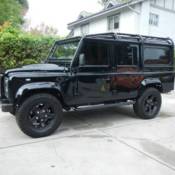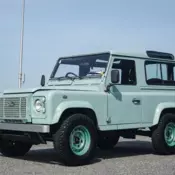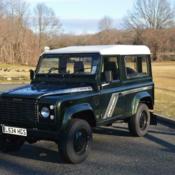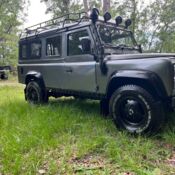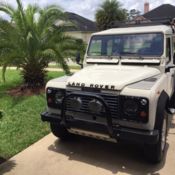Defender 90 3.0TDI LHD
1986 Land Rover Defender
This 1986 Landy came into the world as a natural aspirated model.I purchased it from a dealer here in Florida with about 180,000km (115,000 miles) which isextremely low for these vehicles I was unable to confirm the milage was correct but the milage matched the import documents. I quickly realized that I needed more power because I could not get over 50 MPH on the highway. I decided to go with a 3.0 TDI out of a 1995 model. This conversion required the R380 tranny and transfer case.I spent over 15K on the conversion. The engine was freshened with new rings, bearings and gaskets and new clutch. The conversion looks like the factory did it and it runs fantastic. Why stop there???
I sent it out to get painted and when it came back I realized how ugly the rims and interior looked, so here we go.
New Paint
New NAS Rims
New Tires
New Xmoore Carpet
New Front Seats
New KBX grill
New Brake booster and Master
Freshened 3 TDI
New Rear Face to Face Seats
New Clutch
Refurbished Head Liner
New Updated Steering wheel
New Belts and Hoses (turbo included)
The restoration has about 13,000 miles on it.
This is my daily driver and is very fun, reliable and a real head turner. I am selling her because I just completed and extensive and expensive restoration on my 110 and I do not need two Defenders.EBAY did not recognize the VIN number. The actual VIN is SALLDVBC8AA257421The truck has power steering, power brakes but does not have AC. I added AC to my 110 and it cost about 4k to do right but there are cheaper kits out there.
This is why I chose the 3.0 TDI
Although the 200Tdi engine had been an undoubted technological and sales success, it had certain limitations and flaws that needed to be rectified. Despite the numerous differences, it was still in essence a direct-injection version of the older Diesel Turbo engine.[63]It was also considered rather raucous and unrefined, especially for use in the Discovery and Range Rover models.[67]A special version of the engine had to be produced to fit the Defender, and problems with weakhead gaskethad been identified.[68]The British Army (and some other military buyers) had not opted for the 200Tdi because it could not be fitted with a 24-volt generator for powering radio equipment- instead the Army continued to buy vehicles with 2.5-litre naturally aspirated diesels.[60]UpcomingEuropean diesel emissions regulations(Euro I) meant that Land Rover would be forced to radically alter the engine anyway. The resulting development project (codedRomulus) produced the 300Tdi engine. Although externally very similar to the Discovery/Range Rover version of its predecessor, 208 changes were made. These included modifications to theblock,cylinder head,fuel injector systemand ancillary systems. Thecrankshaft,pistonsandconnecting rodswere significantly altered over the 200Tdi.[69]The most obvious external changes were the fitting of a rubber acoustic cover over the engine to reduce noise and the change to a single serpentine belt to drive the ancillaries instead of the multiple V-belts of the older engines. Emissions regulation included the fitting of anexhaust gas recirculationsystem. Power and torque outputs remained the same, and the engine had been specifically designed to be compatible with all the models in the Land Rover range without any changes. This meant that the Defender engines were fitted in the same tune as the Discovery/Range Rover engines.[60]The 300Tdi was noticeably smoother and quieter than the 200Tdi, but was generally found to not be quite as economical in real-world use.[70]It turned out that the Euro I emissions regulations were not as severe as Land Rover anticipated, and so the 300Tdi was able to remain in production until the introduction of the Euro III rules. When fitted to vehicles with an automatic transmission, power was increased to 122 horsepower to make up for the power losses in the transmission. These engines (designated 23L) had Bosch Electronic Diesel Control systems, where the mechanical injector system was controlled by a drive-by-wire electronic throttle to reduce emissions.[71]The 300Tdi was replaced in 1998 by the 5-cylinder Td5, bringing to an end the line of Land Rover 4-cylinder engines that can be traced back to 1957. The Td5 engine was loosely based on the Rover Group'sL-series diesel engine. The 300Tdi remained in production in Brazil, and was offered as an option on rest of world (non-UK/Europe) models. FollowingFord'sacquisition of Land Rover in 2000, the engine was used inBrazilian-built Fordpick-up trucksas well.[12]Increasing emissions laws worldwide and falling sales led to production of the 300Tdi ending in 2006. A much-modified 2.8-litre version was built by International Engines in Brazil until 2010, and was available as an after-market fitment to Land Rovers through specialist converters.[66][72]International then becameMWM International Motoresand a further update of the 300Tdi design was launched as the 3.0 Power Stroke. Although based around the same block and basic architecture as the 300Tdi the Power Stroke has major differences such as electroniccommon railinjection and new crossflow cylinder head withOverhead camshaft.
Layout: 4-cylinder, in-line
Block/head: Cast iron/aluminium alloy
Valves: OHV, belt-driven camshaft, push-rod operated
Capacity: 2,495cc (152.3cuin)
Bore × stroke: 90.47mm ×97mm (3.562in ×3.819in)
Compression ratio: 19:1
Fuel injection: Bosch VE rotary pump and Bosch two-stage injectors (with Bosch EDC system on versions withautomatic transmission)
Induction: Allied Signal T25 turbocharger
Power: 111hp (83kW) @ 4,250rpm (versions withmanual transmission)
122hp (91kW) @ 4,250rpm (versions with automatic transmission)
Torque: 195lbfâ‹…ft (264Nâ‹…m) @ 1,800rpm (versions with manual transmission)
210lbfâ‹…ft (280Nâ‹…m) @ 1,800rpm (versions with automatic transmission)
Production: 1994-2006
Used in:Land Rover Defender,Discovery, andRange Rover; also various Brazil-assembled Ford pickup trucks.
- Make: Land Rover
- Model: Defender
- SubModel: 90
- Year: 1986
- Mileage: 125,000
- VIN: 00000000000000000
- Color: green
- Engine size: 3.0
- Number of cylinders: 4
- Fuel: Diesel
- Transmission: Manual
- Drive type: 4WD
- Interior color: Black
- Drive side: Left-hand drive
- Options: 4-Wheel Drive, CD Player, Leather Seats
- Vehicle Title: Clear Want to buy? Contact seller!
